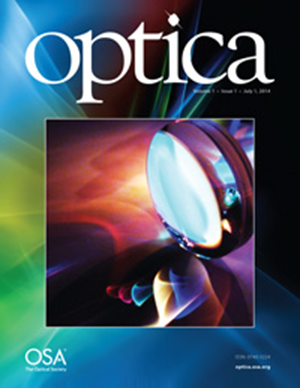用于光谱极坐标热成像的旋转元表面堆栈
IF 8.5
1区 物理与天体物理
Q1 OPTICS
引用次数: 0
摘要
长波红外(LWIR)区域的光谱偏振成像在夜视、机器感知、痕量气体传感和热成像等应用中发挥着至关重要的作用。然而,目前的光谱极坐标长波红外成像仪在尺寸、光谱分辨率和视场(FOV)方面受到限制。虽然基于元光学的光谱极坐标成像策略已在可见光谱中得到探索,但其在热成像方面的潜力在很大程度上仍未得到开发。在这项工作中,我们介绍了一种通过将大面积堆叠元光学器件与先进的计算成像算法相结合来进行光谱极坐标分解的方法。通过将旋转色散元表面堆叠与压缩传感和字典学习算法共同设计,可同时实现光谱和偏振分辨率,而无需使用笨重的滤光轮或干涉仪。我们基于旋转介质面的光谱-偏振堆栈结构紧凑(<10×10×10cm{lt}\;{10} \times {10} \times {10}\;{\rm cm})、坚固耐用,而且视场宽广(20.5°)。我们的研究表明,我们系统的光谱分辨能力大大提高了材料分类等机器学习任务的性能,这是传统全色红外热像仪所面临的挑战。我们的方法代表了热成像领域的一大进步,适用于包括热辅助探测和测距(HADAR)在内的广泛应用。本文章由计算机程序翻译,如有差异,请以英文原文为准。
Spinning metasurface stack for spectro-polarimetric thermal imaging
Spectro-polarimetric imaging in the long-wave infrared (LWIR) region plays a crucial role in applications from night vision and machine perception to trace gas sensing and thermography. However, the current generation of spectro-polarimetric LWIR imagers suffers from limitations in size, spectral resolution, and field of view (FOV). While meta-optics-based strategies for spectro-polarimetric imaging have been explored in the visible spectrum, their potential for thermal imaging remains largely unexplored. In this work, we introduce an approach for spectro-polarimetric decomposition by combining large-area stacked meta-optical devices with advanced computational imaging algorithms. The co-design of a stack of spinning dispersive metasurfaces along with compressive sensing and dictionary learning algorithms allows simultaneous spectral and polarimetric resolution without the need for bulky filter wheels or interferometers. Our spinning-metasurface-based spectro-polarimetric stack is compact (<10×10×10cm) and robust, and it offers a wide field of view (20.5°). We show that the spectral resolving power of our system substantially enhances performance in machine learning tasks such as material classification, a challenge for conventional panchromatic thermal cameras. Our approach represents a significant advance in the field of thermal imaging for a wide range of applications including heat-assisted detection and ranging (HADAR).
求助全文
通过发布文献求助,成功后即可免费获取论文全文。
去求助
来源期刊

Optica
OPTICS-
CiteScore
19.70
自引率
2.90%
发文量
191
审稿时长
2 months
期刊介绍:
Optica is an open access, online-only journal published monthly by Optica Publishing Group. It is dedicated to the rapid dissemination of high-impact peer-reviewed research in the field of optics and photonics. The journal provides a forum for theoretical or experimental, fundamental or applied research to be swiftly accessed by the international community. Optica is abstracted and indexed in Chemical Abstracts Service, Current Contents/Physical, Chemical & Earth Sciences, and Science Citation Index Expanded.
 求助内容:
求助内容: 应助结果提醒方式:
应助结果提醒方式:


